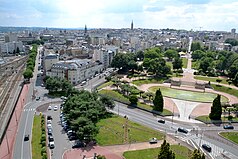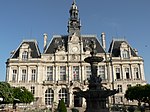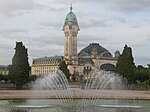
Back Limoges Afrikaans Limoches AN ليموج Arabic ليموچ ARZ Limoges AST Limoges AVK Limoj Azerbaijani لیموژ AZB Лімож Byelorussian Лімож BE-X-OLD
Limoges
Limòtges (Occitan) | |
|---|---|
Prefecture and commune | |
| Coordinates: 45°50′07″N 1°15′45″E / 45.8353°N 1.2625°E | |
| Country | France |
| Region | Nouvelle-Aquitaine |
| Department | Haute-Vienne |
| Arrondissement | Limoges |
| Canton | Limoges-1, 2, 3, 4, 5, 6, 7, 8 and 9 |
| Intercommunality | CU Limoges Métropole |
| Government | |
| • Mayor (2020–2026) | Emile-Roger Lombertie[1] |
| Area 1 | 77.45 km2 (29.90 sq mi) |
| • Urban | 270.9 km2 (104.6 sq mi) |
| • Metro | 3,407 km2 (1,315 sq mi) |
| Population (2021)[2] | 129,760 |
| • Density | 1,700/km2 (4,300/sq mi) |
| • Urban (2018[3]) | 186,799 |
| • Urban density | 690/km2 (1,800/sq mi) |
| • Metro (2018[3]) | 323,789 |
| • Metro density | 95/km2 (250/sq mi) |
| Time zone | UTC+01:00 (CET) |
| • Summer (DST) | UTC+02:00 (CEST) |
| INSEE/Postal code | 87085 /87000 |
| Elevation | 209–431 m (686–1,414 ft) (avg. 294 m or 965 ft) |
| Website | www.ville-limoges.fr |
| 1 French Land Register data, which excludes lakes, ponds, glaciers > 1 km2 (0.386 sq mi or 247 acres) and river estuaries. | |
Limoges (/lɪˈmoʊʒ/,[4][5] US also /liːˈ-/,[4][6] French: [limɔʒ] ;[4] Occitan: Lemòtges, locally Limòtges [liˈmɔdzes]) is a city and commune, and the prefecture of the Haute-Vienne department in west-central France.[7] It was the administrative capital of the former Limousin region. Situated on the first western foothills of the Massif Central, Limoges is crossed by the river Vienne, of which it was originally the first ford crossing point.
The second most populated town in the New Aquitaine region after Bordeaux, a university town, an administrative centre and intermediate services with all the facilities of a regional metropolis, it has an urban area of 323,789 inhabitants in 2018.[3] The inhabitants of the city are called the Limougeauds.
Founded around 10 BC under the name of Augustoritum, it became an important Gallo-Roman city. During the Middle Ages Limoges became a large city, strongly marked by the cultural influence of the Abbey of Saint-Martial, where the Dukes of Aquitaine were invested and crowned. From the 12th century onwards, its enamels were exported throughout the Christian world. In 1765, during the industrial revolution, the discovery of a deposit of kaolin in the Saint-Yrieix-la-Perche region enabled the development of the Limoges porcelain industry. It is sometimes nicknamed "the red city" or "the Rome of socialism" because of its tradition of voting on the left and the workers' events it experienced from the 19th to the beginning of the 20th century.
Since the 1990s, the city has had a basketball club, Limoges CSP, which has won several French championships and the European championship in 1993. Because of its heritage policy, it has held the label "City of Art and History" since 2008. Economic activities include butchering, electrical equipment for the building industry, and luxury goods. It is home to porcelain houses and art workshops working with enamel or stained glass. This craft expertise led it to join the UNESCO Creative Cities Network in 2017 in the thematic category "Crafts and Popular Arts".
- ^ "Répertoire national des élus: les maires" (in French). data.gouv.fr, Plateforme ouverte des données publiques françaises. 13 September 2022.
- ^ "Populations légales 2021". The National Institute of Statistics and Economic Studies. 28 December 2023.
- ^ a b c Cite error: The named reference
comparwas invoked but never defined (see the help page). - ^ a b c "Limoges". Collins English Dictionary. HarperCollins. Retrieved 24 September 2014.
- ^ "Limoges". Merriam-Webster.com Dictionary. Retrieved 1 July 2019.
- ^ "Limoges". The American Heritage Dictionary of the English Language (5th ed.). HarperCollins. Retrieved 1 July 2019.
- ^ INSEE commune file
© MMXXIII Rich X Search. We shall prevail. All rights reserved. Rich X Search









